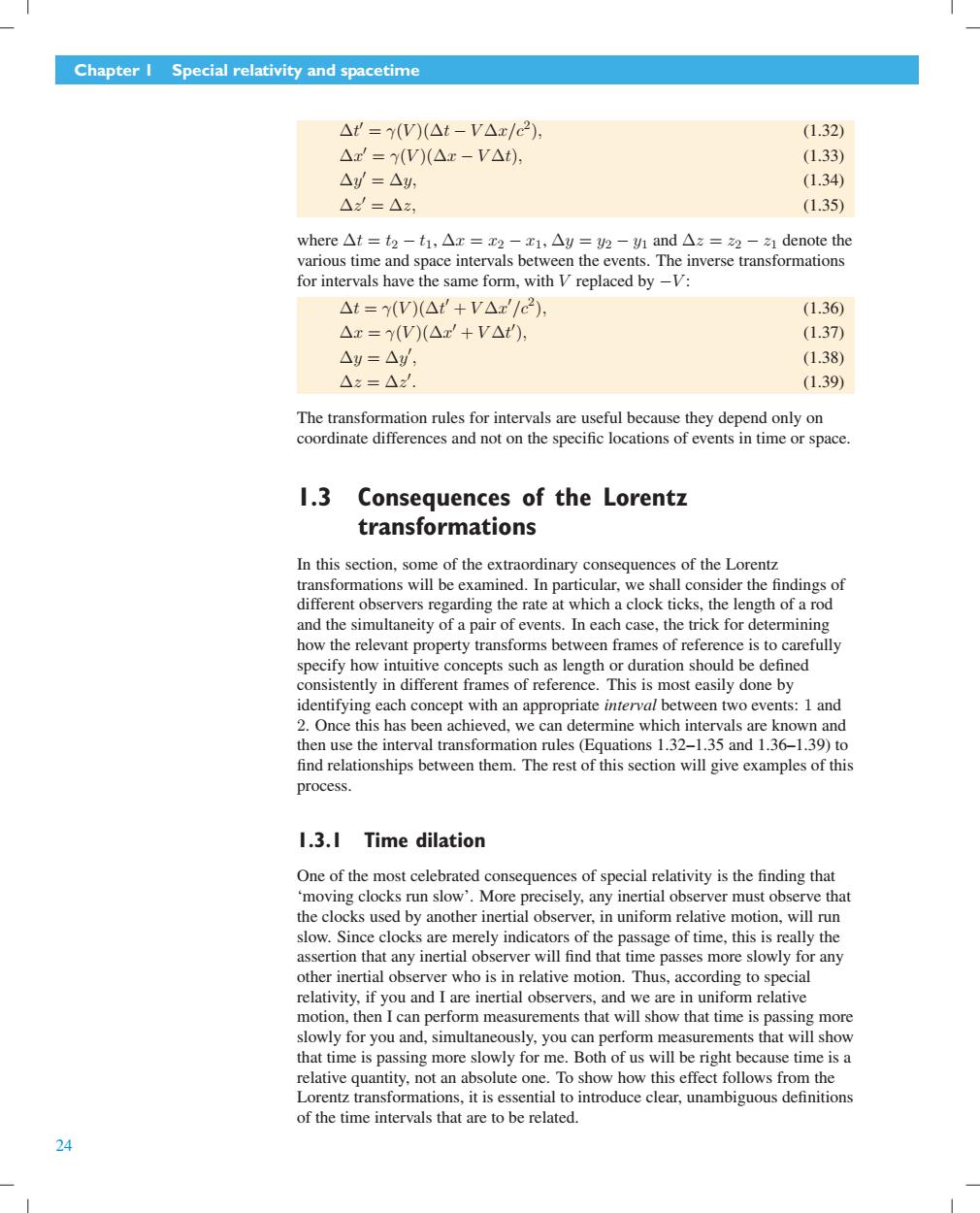正在加载图片...

Chapter I Special relativity and spacetime △t=y(V)(△t-V△x/c2), (1.32) △x=y(V)(△x-V△t), (1.33) △y=△y (1.34) △=△z, (1.35) where△t=t2-t1,△x=x2-x1,△y=y2-y1and△z=2-denote the various time and space intervals between the events.The inverse transformations for intervals have the same form,with V replaced by-V: △t=y(W)(△t+V△x/c2). (1.36) △x=y(V)(△x'+V△t): (1.37) △y=△y, (1.38) △z=△z (1.39) The transformation rules for intervals are useful because they depend only on coordinate differences and not on the specific locations of events in time or space. 1.3 Consequences of the Lorentz transformations In this section,some of the extraordinary consequences of the Lorentz transformations will be examined.In particular,we shall consider the findings of different observers regarding the rate at which a clock ticks,the length of a rod and the simultaneity of a pair of events.In each case,the trick for determining how the relevant property transforms between frames of reference is to carefully specify how intuitive concepts such as length or duration should be defined consistently in different frames of reference.This is most easily done by identifying each concept with an appropriate interval between two events:1 and 2.Once this has been achieved,we can determine which intervals are known and then use the interval transformation rules(Equations 1.32-1.35 and 1.36-1.39)to find relationships between them.The rest of this section will give examples of this process. 1.3.I Time dilation One of the most celebrated consequences of special relativity is the finding that 'moving clocks run slow'.More precisely,any inertial observer must observe that the clocks used by another inertial observer,in uniform relative motion,will run slow.Since clocks are merely indicators of the passage of time,this is really the assertion that any inertial observer will find that time passes more slowly for any other inertial observer who is in relative motion.Thus,according to special relativity,if you and I are inertial observers,and we are in uniform relative motion,then I can perform measurements that will show that time is passing more slowly for you and,simultaneously,you can perform measurements that will show that time is passing more slowly for me.Both of us will be right because time is a relative quantity,not an absolute one.To show how this effect follows from the Lorentz transformations.it is essential to introduce clear,unambiguous definitions of the time intervals that are to be related. 24Chapter 1 Special relativity and spacetime Δt % = γ(V )(Δt − V Δx/c2 ), (1.32) Δx % = γ(V )(Δx − V Δt), (1.33) Δy % = Δy, (1.34) Δz % = Δz, (1.35) where Δt = t2 − t1, Δx = x2 − x1, Δy = y2 − y1 and Δz = z2 − z1 denote the various time and space intervals between the events. The inverse transformations for intervals have the same form, with V replaced by −V : Δt = γ(V )(Δt % + V Δx % /c2 ), (1.36) Δx = γ(V )(Δx % + V Δt % ), (1.37) Δy = Δy % , (1.38) Δz = Δz % . (1.39) The transformation rules for intervals are useful because they depend only on coordinate differences and not on the specific locations of events in time or space. 1.3 Consequences of the Lorentz transformations In this section, some of the extraordinary consequences of the Lorentz transformations will be examined. In particular, we shall consider the findings of different observers regarding the rate at which a clock ticks, the length of a rod and the simultaneity of a pair of events. In each case, the trick for determining how the relevant property transforms between frames of reference is to carefully specify how intuitive concepts such as length or duration should be defined consistently in different frames of reference. This is most easily done by identifying each concept with an appropriate interval between two events: 1 and 2. Once this has been achieved, we can determine which intervals are known and then use the interval transformation rules (Equations 1.32–1.35 and 1.36–1.39) to find relationships between them. The rest of this section will give examples of this process. 1.3.1 Time dilation One of the most celebrated consequences of special relativity is the finding that ‘moving clocks run slow’. More precisely, any inertial observer must observe that the clocks used by another inertial observer, in uniform relative motion, will run slow. Since clocks are merely indicators of the passage of time, this is really the assertion that any inertial observer will find that time passes more slowly for any other inertial observer who is in relative motion. Thus, according to special relativity, if you andIare inertial observers, and we are in uniform relative motion, then I can perform measurements that will show that time is passing more slowly for you and, simultaneously, you can perform measurements that will show that time is passing more slowly for me. Both of us will be right because time is a relative quantity, not an absolute one. To show how this effect follows from the Lorentz transformations, it is essential to introduce clear, unambiguous definitions of the time intervals that are to be related. 24